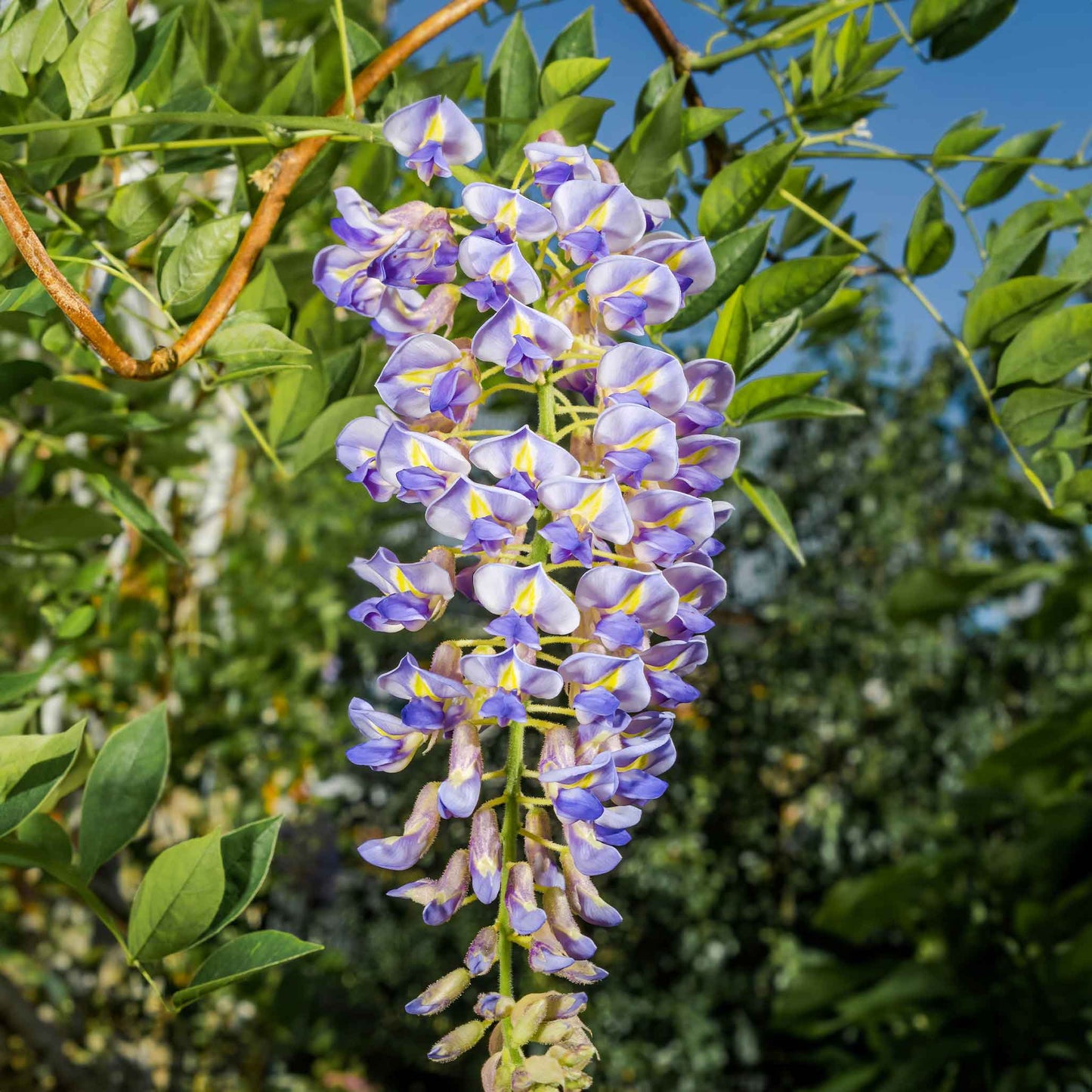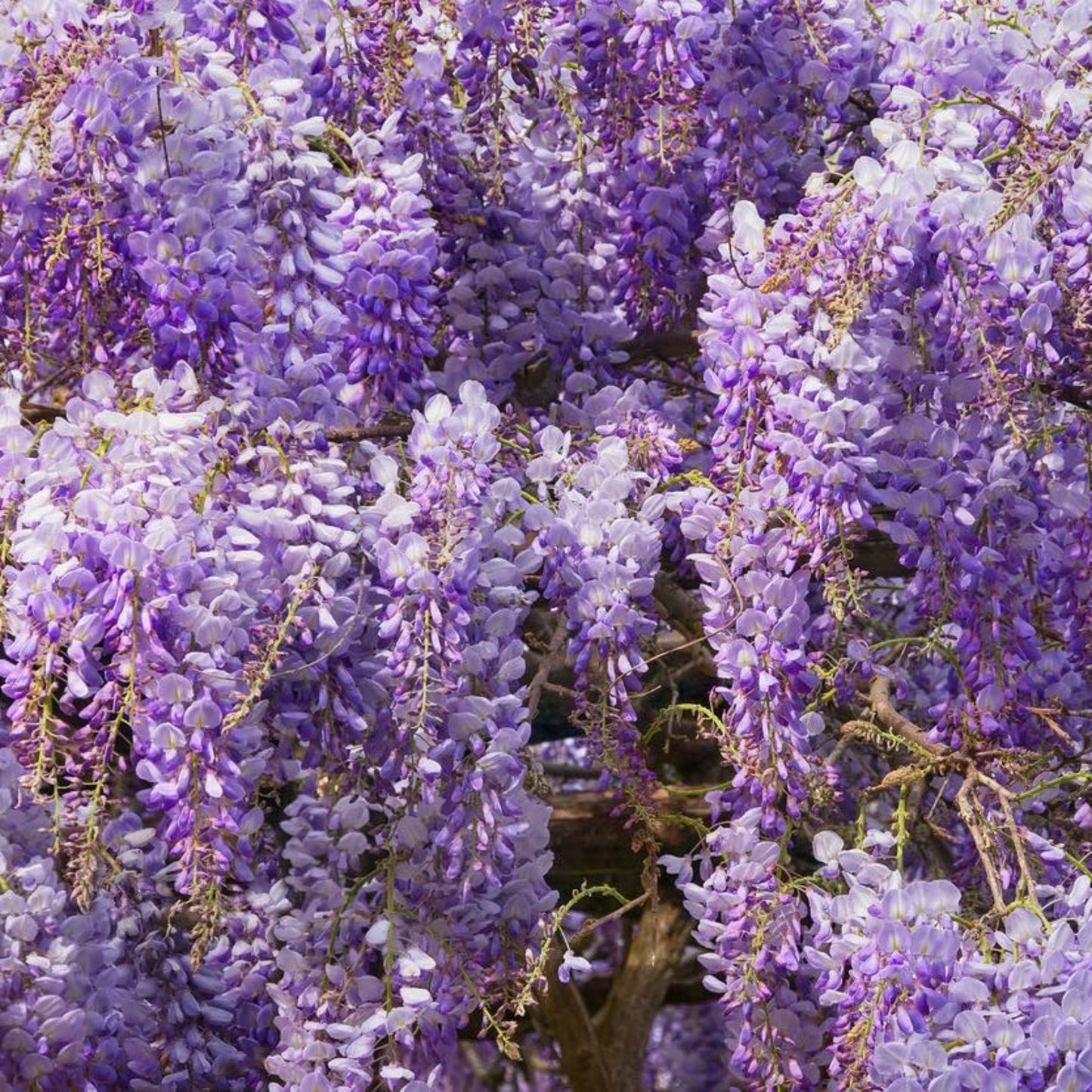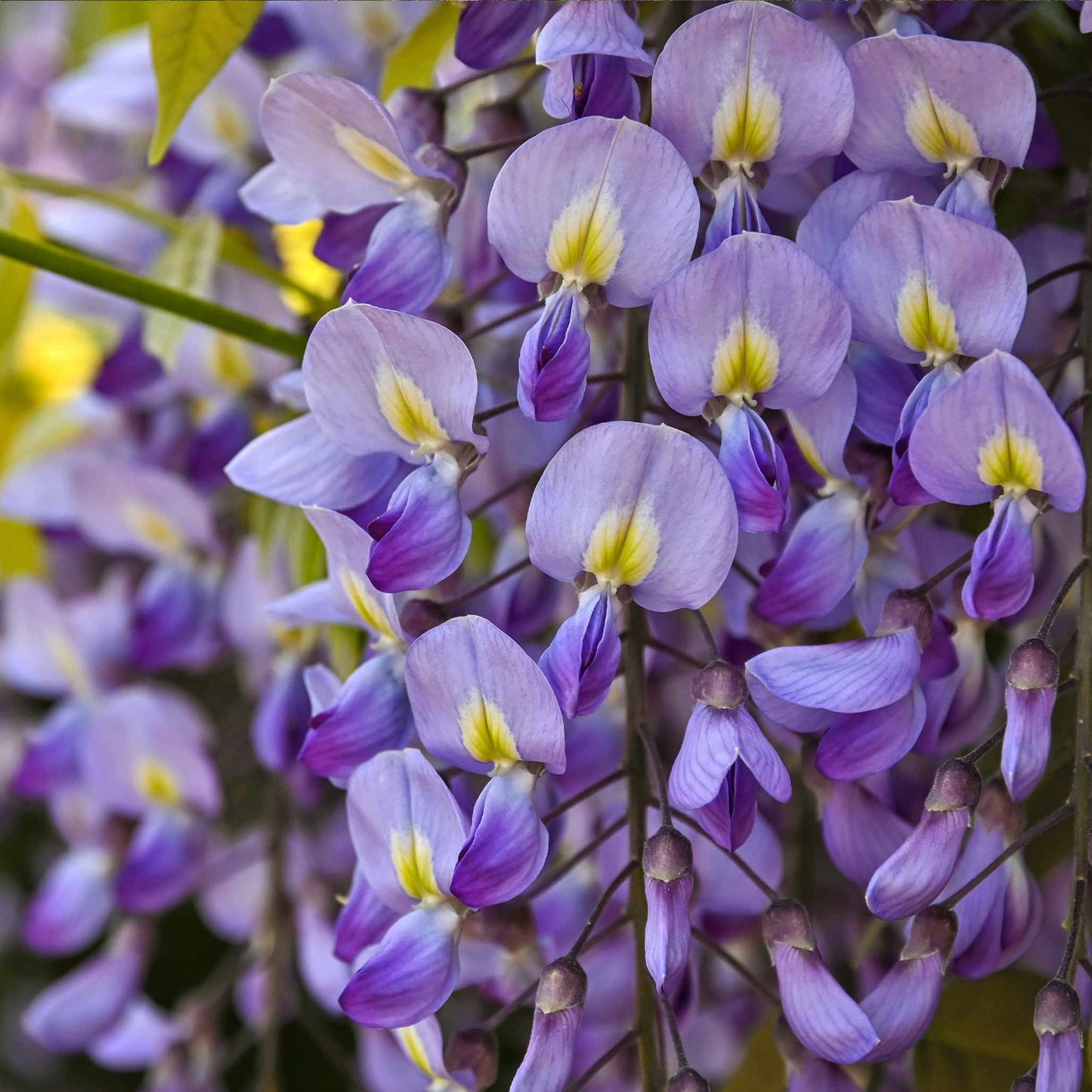Blue Moon Wisteria
Blue Moon Wisteria
SKU:PER-VIN-BLU-34-5G
Get Ready to Be Moonstruck by Blue Moon Wisteria!
Imagine a cascade of sweet-smelling, lavender-blue flowers draping from your trellis or porch. Our Blue Moon Wisteria is a hardy climber that promises to bring a touch of whimsy and romance to your garden space.
Why Blue Moon Wisteria?
- Robust and Winter-Hardy: This variety is a survivor, thriving in zones 4 through 9 and able to withstand some of the chilliest winters.
- Repeat Bloomer: Not a one-season wonder, Blue Moon Wisteria graces your garden with multiple blooming periods throughout the spring and summer.
- Fast Grower: With the right care, watch it swiftly climb to new heights, reaching up to 25 feet or more.
- Easy to Manage: While some wisterias can be a tad unruly, Blue Moon is known for its manageability and is less aggressive than other varieties.
Planting & Care Tips
Blue Moon Wisteria is a cinch to grow. Full sun and well-draining soil will get you those enchanting blooms in no time. A little support and occasional pruning will keep your wisteria in top shape, ensuring a stunning display year after year.
Bring the Magic Home
Whether you're aiming to add a splash of color to your outdoor living area or dreaming of a fragrant walkway, our Blue Moon Wisteria is the perfect pick. Order yours today and let the moonlight magic begin!




Product Details
-
Product Category
Perennials
-
Product Subcategory:
Vines
-
Botanical Name:
Wisteria macrostachya 'Blue Moon'
-
Does Not Ship To:
AZ, OR
-
Mature Height:
25 ft.
-
Mature Width:
20 ft.
-
Growing Zone:
4-9 outdoors
-
Indoor Growing:
-
Sunlight:
Full-Part Sun
-
Growth Rate:
Moderate
-
Harvest Time:
-
Bloom Time:
Spring, Summer

Planting Directions
<h2>Planting Blue Moon Wisteria</h2>
<p>To plant Blue Moon Wisteria, follow these steps:</p>
<ul>
<li><strong>Location:</strong> Choose a sunny spot with at least 6 hours of sunlight and well-draining soil.</li>
<li><strong>Support Structure:</strong> Provide a sturdy trellis or arbor, as wisteria can become heavy.</li>
<li><strong>Planting:</strong> Dig a hole twice as wide and just as deep as the root ball. Place the plant in the hole, backfill with soil, and water thoroughly.</li>
<li><strong>Spacing:</strong> Allow 10-15 feet between plants to accommodate their growth.</li>
</ul>
<h2>Care and Maintenance</h2>
<p>For ongoing care of Blue Moon Wisteria:</p>
<ul>
<li><strong>Watering:</strong> Keep the soil moist but not waterlogged, especially during the first season.</li>
<li><strong>Fertilization:</strong> Apply a balanced fertilizer in spring as new growth appears.</li>
<li><strong>Pruning:</strong> Prune in late winter to shape the plant and promote flowering. Remove at least half of the previous year's growth, leaving a few buds per stem.</li>
<li><strong>Pest Control:</strong> Inspect regularly for pests and treat as necessary.</li>
</ul>
<h2>Pollination and Harvesting</h2>
<p>Blue Moon Wisteria does not require manual pollination and does not produce harvestable fruit. Enjoy the plant for its stunning blooms.</p>
<p>Remember, wisteria can take a few years to bloom, so be patient. With proper care, your Blue Moon Wisteria will become a breathtaking addition to your garden.</p>

FAQs
<h2>FAQs for the Blue Moon Wisteria</h2>
<h3>1. How do I plant Blue Moon Wisteria?</h3>
<ol>
<li><strong>Choose the right location:</strong> Select a spot with full sun to partial shade and well-draining soil. Wisteria thrives in a sunny position to bloom profusely.</li>
<li><strong>Prepare the soil:</strong> Loosen the soil to a depth of 18-24 inches and mix in compost or well-rotted manure to enrich the soil.</li>
<li><strong>Dig the hole:</strong> Make the hole twice as wide and just as deep as the root ball of your wisteria.</li>
<li><strong>Plant the wisteria:</strong> Remove the plant from its pot and gently loosen the roots. Place it in the hole, ensuring it's at the same depth it was in the pot. Fill the hole with soil and water thoroughly.</li>
<li><strong>Support:</strong> Install a sturdy support structure like a trellis or pergola at planting time, as wisteria vines grow heavy with age.</li>
</ol>
<h3>2. How do I water and fertilize Blue Moon Wisteria?</h3>
<ul>
<li><strong>Watering:</strong> Keep the soil consistently moist but not waterlogged during the first growing season. Once established, wisteria is quite drought-tolerant but benefits from occasional deep watering during dry spells.</li>
<li><strong>Fertilization:</strong> Apply a balanced, slow-release fertilizer in early spring. Avoid high-nitrogen fertilizers, which can encourage leaf growth at the expense of flowers.</li>
</ul>
<h3>3. How do I prune Blue Moon Wisteria?</h3>
<p><strong>Pruning is crucial</strong> for controlling growth and encouraging flowering. Conduct major pruning in late winter to remove unwanted growth and shape the vine. In summer, after flowering, trim back this season's growth to 6 inches to promote branching and increase the number of flowering spurs.</p>
<h3>4. How do I ensure my Blue Moon Wisteria blooms?</h3>
<ul>
<li><strong>Sunlight:</strong> Ensure your wisteria receives at least 6 hours of direct sunlight daily.</li>
<li><strong>Pruning:</strong> Proper pruning, as mentioned above, encourages flowering.</li>
<li><strong>Patience:</strong> Wisteria can take several years to bloom for the first time. Providing proper care and avoiding high-nitrogen fertilizers can help.</li>
</ul>
<h3>5. How do I deal with pests and diseases?</h3>
<p><strong>Maintain good plant health</strong> as the first defense against pests and diseases. Keep an eye out for common issues like aphids, leaf spots, and root rot. Treat infestations or infections early, using appropriate organic or chemical treatments as necessary. Ensuring proper air circulation around the plant and avoiding overhead watering can help prevent many fungal diseases.</p>





